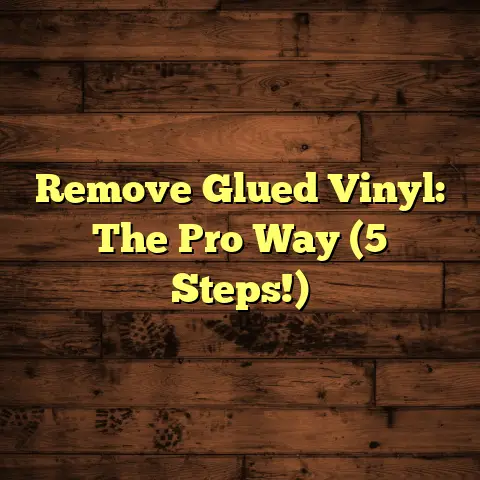Fix Damaged Wood Floors: A Guide (4 DIY Pro Secrets!)
A Guide (4 DIY Pro Secrets!)
I’m your friendly neighborhood flooring contractor, and I’m here to spill the beans on how you can tackle those pesky wood floor damages yourself.
Let’s face it: wood floors are gorgeous, but they’re also prone to scratches, dents, and all sorts of wear and tear.
But don’t fret!
With a little know-how and some elbow grease, you can restore your floors to their former glory.
My goal here is simple: to empower you with the knowledge and skills to repair and restore your damaged wood floors like a pro.
Think of the satisfaction of improving your living space, preserving the beauty of natural wood, and saving a ton of money compared to hiring professionals.
Ready to get started? Let’s dive in!
1. Understanding Wood Floor Damage
First things first, let’s talk about the different types of damage your wood floors might be facing.
Knowing what you’re dealing with is half the battle!
Here are some common culprits:
-
Scratches: These can range from superficial surface scratches to deeper gouges.
-
Dents: Impact from heavy objects can leave unsightly dents.
-
Water Damage: Spills, leaks, and high humidity can cause warping, staining, and even rot.
-
Warping: Changes in humidity and temperature can cause wood to expand and contract, leading to warping.
-
Discoloration: Sunlight, spills, and age can cause discoloration or fading.
What causes these damages, you ask?
Well, it’s a mix of factors:
-
Furniture movement: Dragging furniture without proper protection is a major cause of scratches.
-
Pet claws: Our furry friends can leave their mark, especially on softer wood floors.
-
Moisture: Water is the enemy of wood! Spills, leaks, and high humidity can wreak havoc.
-
Temperature fluctuations: Extreme temperature changes can cause wood to expand and contract, leading to warping and cracking.
-
Lack of maintenance: Neglecting regular cleaning and maintenance can accelerate wear and tear.
Why is identifying the type of damage so important?
Because it helps you determine the best repair approach.
A simple scratch requires a different solution than a water-damaged board. Knowing the enemy is crucial!
2. Essential Tools and Materials
Alright, now that we know what we’re up against, let’s gather our arsenal of tools and materials.
Here’s a breakdown of what you’ll need for each type of repair:
-
For Scratches:
- Sandpaper (various grits, from 120 to 320)
- Wood markers or crayons (matching your floor color)
- Wood filler (for deeper scratches)
- Putty knife
- Soft cloths
- Polyurethane finish (matching your floor’s sheen)
-
For Dents:
- Iron
- Damp cloth
- Sandpaper (various grits)
- Wood filler (if necessary)
- Putty knife
- Wood stain (matching your floor color)
- Polyurethane finish
-
For Water Damage:
- Moisture meter (to assess the extent of the damage)
- Dehumidifier or fans
- Wood cleaner
- Sandpaper
- Wood stain
- Polyurethane finish
- Replacement wood boards (if necessary)
- Circular saw or hand saw
- Hammer
- Nails or wood adhesive
-
For Refinishing:
- Drum sander or orbital sander
- Sandpaper (various grits)
- Edger sander
- Wood stain
- Polyurethane finish
- Paintbrushes or applicators
- Respirator or dust mask
- Safety glasses
A few notes on materials:
-
Wood filler: Choose a wood filler that’s paintable and stainable. Epoxy-based fillers are stronger but can be more difficult to work with. I usually pick up DAP Plastic Wood-X with DryDex Dry Time Indicator because of its stainable features that do not shrink or crack. (Source: DAP)
-
Wood stain: Test the stain on an inconspicuous area of your floor to ensure it matches the existing color.
-
Polyurethane finish: Choose between oil-based and water-based polyurethane. Oil-based is more durable but has a strong odor and takes longer to dry. Water-based is low-odor and dries quickly but may not be as durable.
Where can you get these tools and materials?
Your local hardware store is a great place to start.
Big box stores like Home Depot and Lowe’s also have a wide selection.
You can also find many of these items online at retailers like Amazon.
3. DIY Pro Secret #1: Repairing Surface Scratches and Minor Dents
Alright, let’s get our hands dirty!
Our first pro secret is all about tackling those annoying surface scratches and minor dents.
For surface scratches:
-
Clean the area: Use a soft cloth and a wood cleaner to remove any dirt or debris.
-
Choose your weapon: For light scratches, a wood marker or crayon that matches your floor color can work wonders. Simply apply the marker or crayon to the scratch, following the grain of the wood.
-
Blend it in: Use a soft cloth to gently blend the color into the surrounding area.
-
For deeper scratches: You’ll need to use wood filler. Apply a small amount of filler to the scratch, using a putty knife to press it in.
-
Let it dry: Allow the filler to dry completely according to the manufacturer’s instructions.
-
Sand it smooth: Use fine-grit sandpaper (220-320 grit) to sand the filled area smooth. Be careful not to sand too much, or you’ll remove the surrounding finish.
-
Apply finish: Apply a thin coat of polyurethane finish to the repaired area, matching the sheen of your floor. Let it dry completely.
For minor dents:
This trick might sound crazy, but it works!
-
Dampen the area: Place a damp cloth over the dent.
-
Apply heat: Set your iron to a low setting and gently iron over the damp cloth for a few minutes. The heat and moisture will help the wood fibers swell and pop the dent out.
-
Repeat if necessary: You may need to repeat this process several times to fully remove the dent.
-
Sand it smooth: Once the dent is gone, lightly sand the area with fine-grit sandpaper to smooth it out.
-
Apply finish: Apply a thin coat of polyurethane finish to the repaired area.
Tips for matching color and finish:
-
Test, test, test: Always test your wood marker, crayon, or stain in an inconspicuous area before applying it to the damaged spot.
-
Layer colors: If you can’t find an exact match, try layering different colors to create a custom blend.
-
Sheen matters: Make sure the sheen of your polyurethane finish matches your floor. Most floors have a satin or semi-gloss finish.
4. DIY Pro Secret #2: Fixing Deeper Dents and Gouges
Okay, so what if you’re dealing with a dent or gouge that’s more than just a minor inconvenience?
Don’t worry, I’ve got you covered!
This pro secret focuses on filling those deeper imperfections and making them disappear.
-
Clean the area: As always, start by cleaning the area around the dent or gouge.
-
Apply wood filler: Use a putty knife to apply wood filler to the dent or gouge, slightly overfilling it.
-
Let it dry: Allow the filler to dry completely according to the manufacturer’s instructions. This may take several hours or even overnight.
-
Sand it smooth: Once the filler is dry, use medium-grit sandpaper (120-180 grit) to sand it down to the level of the surrounding floor. Then, switch to fine-grit sandpaper (220-320 grit) to smooth it out.
-
Color-match the filler: If the wood filler doesn’t match the color of your floor, you’ll need to stain it. Use a small brush to apply the stain to the filled area, blending it into the surrounding wood.
-
Apply finish: Finally, apply a thin coat of polyurethane finish to the repaired area, overlapping slightly onto the surrounding floor. This will help to blend the repair and protect the wood.
The importance of a protective finish:
A protective finish is crucial for ensuring the durability of your repair.
Polyurethane finish not only protects the wood from scratches and wear, but it also helps to seal it against moisture.
Without a finish, your repair is vulnerable to damage and could eventually fail.
5. DIY Pro Secret #3: Addressing Water Damage and Warping
Water damage is a wood floor’s worst nightmare.
If left untreated, it can lead to warping, staining, and even rot.
This pro secret will teach you how to assess the extent of water damage and take the necessary steps to repair it.
-
Assess the damage: Use a moisture meter to determine how much moisture is present in the wood. A reading above 12% indicates excessive moisture.
-
Dry it out: If the damage is localized, use a dehumidifier or fans to dry out the affected area.
-
Remove standing water: Mop up any standing water immediately.
-
Clean the area: Use a wood cleaner to remove any dirt or debris.
-
Replace damaged boards: If the water damage is severe, you may need to replace the affected boards.
-
Carefully remove the damaged boards using a pry bar or chisel.
-
Cut replacement boards to the correct size and shape.
-
Apply wood adhesive to the subfloor and install the new boards.
-
Nail the new boards in place, countersinking the nails.
-
Fill the nail holes with wood filler.
-
Sand the new boards smooth.
-
Stain the new boards to match the existing floor.
-
Apply a protective finish.
-
Tips on matching wood grain and color:
-
Buy extra boards: When purchasing replacement boards, buy a few extra so you can choose the ones that best match the existing floor.
-
Mix and match: If you can’t find an exact match, try mixing and matching boards from different sources to create a more natural look.
-
Feather the edges: When staining the new boards, feather the edges to blend them into the surrounding floor.
6. DIY Pro Secret #4: Refinishing Your Wood Floors
If your wood floors are looking tired and worn, refinishing them can bring them back to life.
This pro secret is a comprehensive guide on how to refinish your wood floors like a pro.
-
Preparation:
-
Remove all furniture and rugs from the room.
-
Cover doorways and vents with plastic sheeting to contain dust.
-
Wear a respirator or dust mask and safety glasses.
-
-
Sanding:
-
Rent a drum sander or orbital sander from your local hardware store.
-
Start with a coarse-grit sandpaper (36-40 grit) to remove the old finish.
-
Sand in the direction of the wood grain, overlapping each pass by about 50%.
-
Use an edger sander to sand along the edges of the room.
-
Switch to a medium-grit sandpaper (60-80 grit) and repeat the sanding process.
-
Finally, switch to a fine-grit sandpaper (100-120 grit) and repeat the sanding process.
-
-
Staining (optional):
-
If you want to change the color of your floors, apply a wood stain after sanding.
-
Apply the stain evenly, using a brush or applicator.
-
Wipe off any excess stain with a clean cloth.
-
Allow the stain to dry completely according to the manufacturer’s instructions.
-
-
Applying Finish:
-
Apply a thin coat of polyurethane finish to the floor, using a brush or applicator.
-
Allow the finish to dry completely according to the manufacturer’s instructions.
-
Apply a second coat of finish for added durability.
-
DIY vs. Hiring Professionals:
Refinishing wood floors is a challenging but rewarding DIY project.
However, it’s important to consider the pros and cons of doing it yourself versus hiring professionals.
DIY:
-
Pros: Cost savings, sense of accomplishment.
-
Cons: Time-consuming, physically demanding, requires specialized equipment, potential for mistakes.
Professionals:
-
Pros: Faster, less physically demanding, guaranteed results.
-
Cons: More expensive.
Tips on selecting the right finish:
-
Oil-based polyurethane: More durable, longer drying time, strong odor.
-
Water-based polyurethane: Less durable, faster drying time, low odor.
-
Consider your lifestyle: If you have pets or children, you may want to choose a more durable finish.
7. Maintenance Tips for Preventing Future Damage
Prevention is always better than cure!
Here’s some practical advice on how to maintain your wood floors to avoid damage and keep them looking pristine.
-
Use furniture pads: Place felt pads under the legs of all furniture to prevent scratches.
-
Regular cleaning: Sweep or vacuum your floors regularly to remove dirt and debris.
-
Use a damp mop: Use a damp mop with a wood floor cleaner to clean your floors weekly.
-
Control humidity: Maintain a consistent humidity level in your home to prevent warping.
-
Avoid spills: Clean up spills immediately to prevent water damage.
-
Periodic inspections: Inspect your floors regularly for signs of damage and address them promptly.
-
Invest in area rugs and mats: Place area rugs and mats in high-traffic areas to protect your floors from wear and tear.
Conclusion
So there you have it!
My ultimate guide to fixing damaged wood floors.
With the right knowledge, tools, and a little bit of elbow grease, you can tackle these projects yourself and save a ton of money.
Remember, maintaining and restoring your wood floors is not just about aesthetics; it’s also about preserving the value of your home.
So go ahead, take pride in your skills, transform your living space, and enjoy the beauty of your revitalized wood floors!





